One Man’s Epic Quest to Build a 20,000-Piece LEGO Star Destroyer
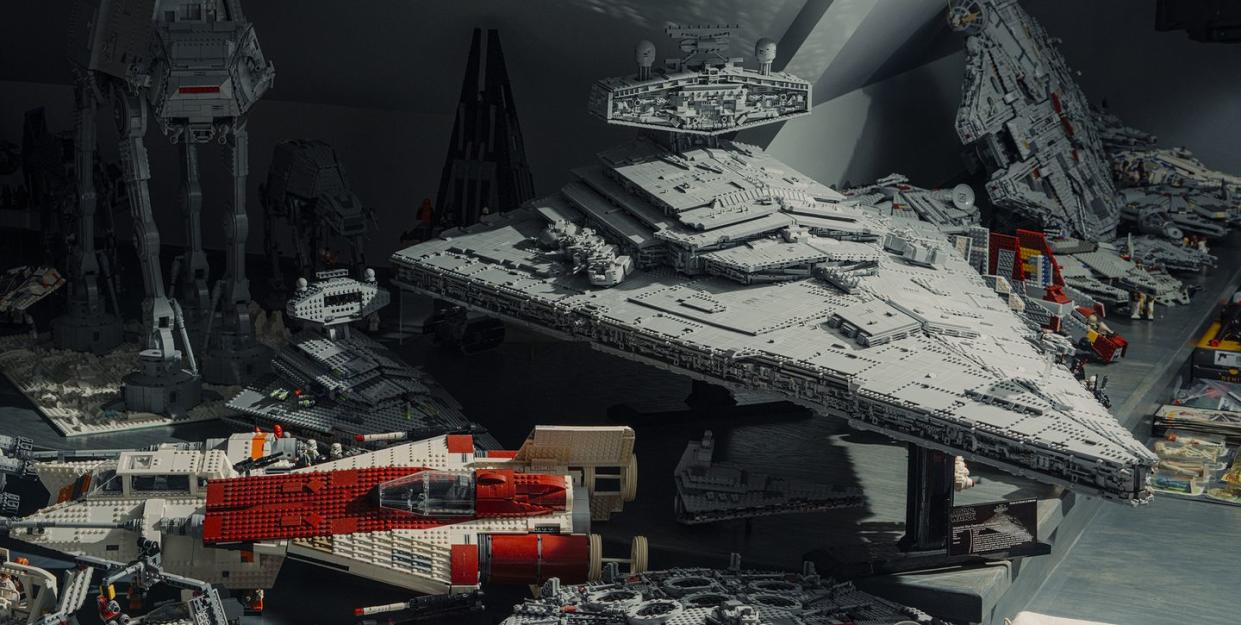
Charles Anderson's Star Destroyer stretches almost 5 feet long, but opposite the enormity is an attention to detail—the filigree of LEGO figurine hands ringing the docking bay; the barnacle-like swath of pipes that make up the vents, pipes, and cannons—that makes the ship an artistic, architectural marvel.
It took Charles 15 months and more than 500 hours to design and build his LEGO version of the iconic Imperial Star Destroyer, first imprinted on the collective consciousness when it crawled across the opening shot of Star Wars in 1977. Like the ship in the movie, Charles’s destroyer intimidates with its size. Weighing 44 pounds, the creation boasts almost 20,000 LEGO bricks, three times as many as the biggest set LEGO has ever published (the 2017 Star Wars: Millennium Falcon set, priced at $800).
But it’s not the mass, weight, or obsessive detail that make Charles’s starship so remarkable. “There are definitely bigger and more impressive LEGO Star Destroyers out there,” says Charles, 43, a senior technical animator in Raleigh, North Carolina. “I’ve seen one over 10 feet long.” His construction is distinct because it’s custom, the first such LEGO model he’s built.
Charles credits his Star Destroyer to a digital revolution transforming LEGO fandom. Throughout LEGO’s 62-year history, die-hards have always built wild, imaginative models from their plastic scrap heaps, but a new wave of fan-made digital resources has given builders the tools to craft custom models that rival the detail and integrity of official LEGO sets. Whether you’re looking for cutting-edge software to design your next project or a site that can generate a piece-by-piece instruction booklet, it’s likely out there, free for download.
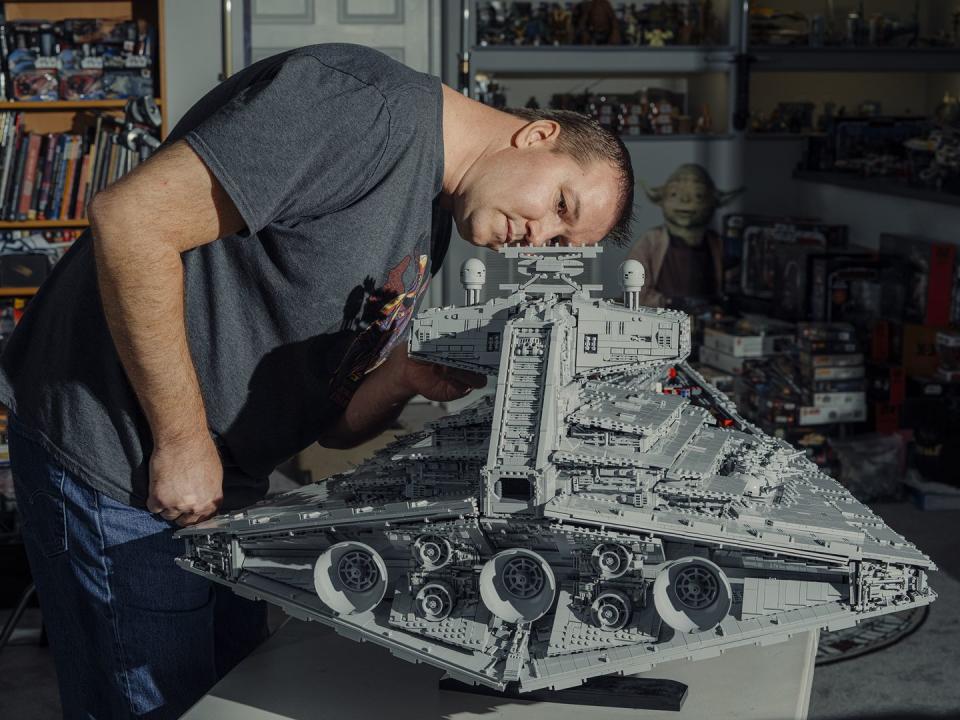
The Digital Toolbox
Like most new LEGO projects, Charles’s ship materialized on a computer before he started clicking bricks together.
Today, fan-written LEGO programs like Bricksmith, LDraw, and Studio 2.0 allow builders to “try out ideas without needing to dig through your tub of LEGOs or go out and find parts at a garage sale,” says Jacob Moore, creative director at BrickLink, a LEGO fan forum, brick market, and publisher of the Studio 2.0 design program. Charles used Studio 2.0 for his Star Destroyer after struggling with LEGO Digital Designer, the LEGO Group’s in-house program. He says he made the switch because the fan software felt similar to the professional programs he used at his animation job. The intuitive system surprised him. “I hadn’t tried a project like this because I thought I’d need all the parts in front of me,” he says.
As a collector and hobbyist-crafter of Star Wars props—Charles just finished a life-size replica of Han Solo trapped in carbonite—Charles’s first concern was making sure his LEGO Star Destroyer would be as close to film fidelity as possible. Given that the ship is shaped like an acute triangle, precision with the structure’s angles was paramount. “I decided at the beginning I wanted the whole thing to be 5 feet long,” says Charles. “That triggered a lot of the other choices I had to make about proportions.”
Charles acquired a publicly available 3D scan of the A New Hope Imperial Star Destroyer and overlaid it into Studio 2.0 to design the skeleton of his build. Once he had the hull mapped out, he moved on to the specifics. “Of the 15 months I spent designing and building this thing, most were spent in this software,” he says. “I jumped back and forth a lot between crafting the aesthetically pleasing parts of the model—the plating and turrets—and refining the superstructure underlying it all. Every time I designed something, I had to find places to hook it together. I just hoped it would stick without breaking apart.”
Charles’ biggest design challenge (and concession) was the ship’s bridge—the oblong hexagon that towers above the wedge-like body. “I wanted it to be proportionally accurate,” he says. “But I had to give in and make it about four studs too wide. I had all these beautiful design elements that wouldn’t fit if I made it smaller, and I couldn’t bear to lose them.”
After 11 months, Charles’s design was finished, and Studio 2.0 gave him a parts list of almost 20,000 individual bricks, which he uploaded into a fan-written inventory software called BrickStock.
BrickStock is connected to a database of every type of individual brick the LEGO Group has ever produced. LEGO has more than 3,400 unique plastic pieces in over 60 colors on record, from the classic 2x4 brick to LEGO tires and dinosaur jaws.
Using BrickStock, Charles found he already had about 8,500 of the 20,000 required destroyer pieces from various LEGO sets and lots he’d collected at garage sales and online marketplaces. He purchased some remaining parts from the LEGO Group’s online “Pick A Brick” service, but he sourced most of them from BrickLink, the fan community’s massive secondhand market.
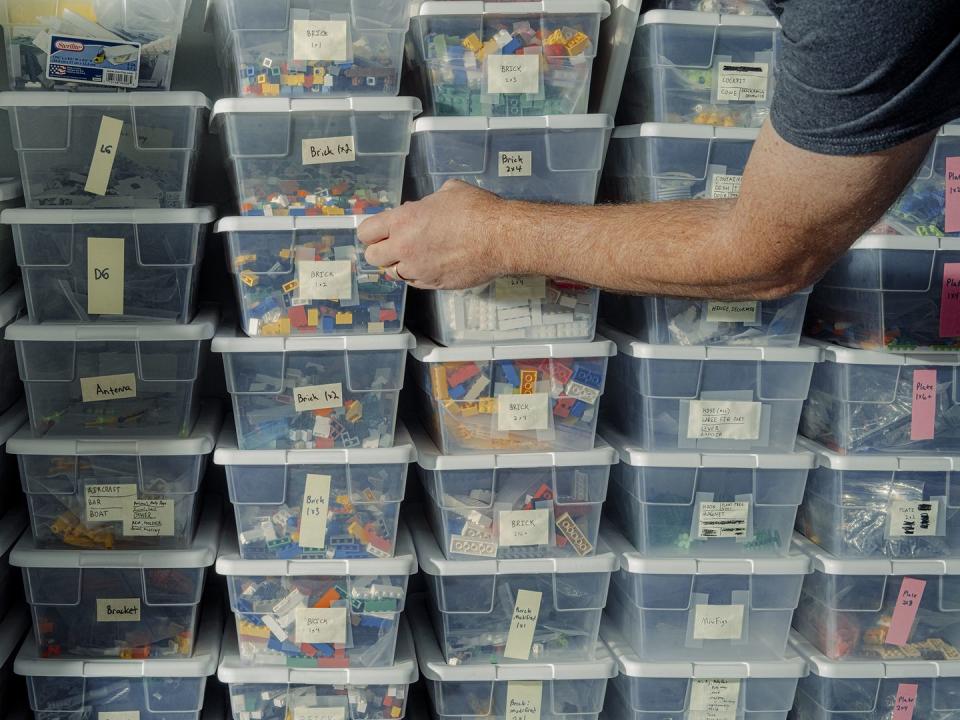
Moore claims BrickLink is the largest eBay-style marketplace for secondhand LEGOs, boasting more than 10,000 worldwide sellers. There’s plenty of supply: The LEGO Group reports producing more than 40 billion bricks annually, about 4 million per hour. What’s more, LEGO announced in late 2019 they would be purchasing BrickLink, so whether you need a few specific parts for a Star Destroyer or as many as you can melt down (more on that later), you can find what you need at going market price: about 11 cents for a workhorse 2x16 gray plate.
As Charles’s bricks poured in, he started assembling his destroyer using the massive 3,300-page custom instruction book provided by Studio 2.0. But by page 200, he says, “things started to fall apart.”
Design flaws spanned the length of the ship. “The engine end broke apart multiple times,” Charles says. “I had all these sharp angles that worked perfectly in my computer model, but refused to stick together in reality, and the tip of the model sagged at the bottom. To fix that, I had to design a way for the last underside panel to lock upward into place.” This wouldn’t be as straightforward as a professional LEGO model, which, by coincidence, was becoming available at the exact same time.
The Real Deal
While Charles was modeling his custom Star Destroyer on Studio 2.0, LEGO commissioned their creative teams to build the exact same ship. The LEGO Group’s official “Ultimate Collector Series Star Wars Imperial Star Destroyer” hit shelves in October 2019.
“I started building it in my free time at work,” says Henrik Andersen, lead designer for the official Imperial Star Destroyer model. Henrik’s supervisors noted his passion project and tasked him to make it official, assigning him a deadline and a price point of about $700. That price cap, hefty as it is, means LEGO’s destroyer is around one-quarter the bricks of Charles’s custom ship. Nevertheless, at 4,784 pieces, the official model is among the biggest sets the company has produced. It takes about 30 hours of brick-clicking to finish.
Henrik and Charles deployed similar engineering strategies to keep their respective 15- and 44-pound models from collapsing or breaking apart. They each relied on a support spine and skeletal system constructed from classic LEGO bricks and load-bearing LEGO Technic bricks (the latter can be fitted with interconnecting axles). And they independently worked out the same solution to locking the starship’s underside panels onto the model—using the bottom spine as leverage for pressing in the pieces.
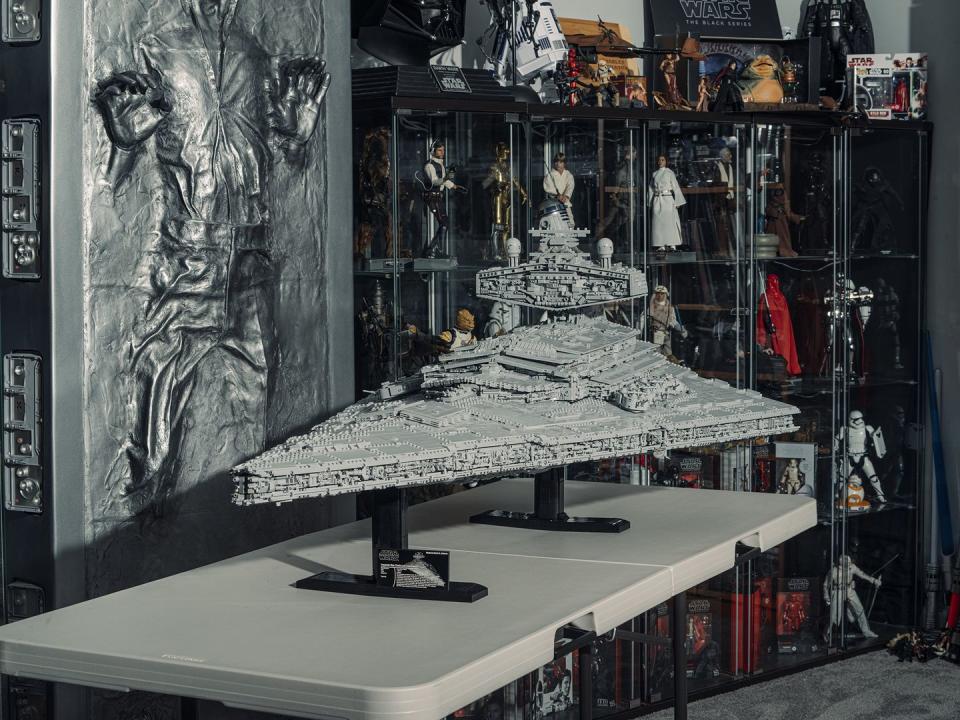
It was the destroyer’s underside hanger (the one that swallows Leia’s cruiser in A New Hope) that posed the biggest test for both builders—and they each took a different approach. “The hanger is almost as deep as the ship, which ends up putting a large hole right where you’d want a support spine to be,” says Charles. Henrik made the official hanger shallower than what you see in the films so a spine could run above it, but Charles bisected his ship’s spine around the space for proportional authenticity. “Making that work was an enormous challenge,” Charles says. “As I added elements to the model, the increasing weight started to pull on [that section of the spine], flexing pieces and pulling apart bricks. At one point I came back from a trip to find the middle of the ship bowing and falling apart because of that hanger.” Charles had to redesign the weight-bearing spine of his 44-pound beast twice, adding more supporting ribs and adjusting the anchor points of his underside panels.
Charles’s model is sleeker and more true-to-film than Henrik’s, who says he “tried to balance the studs and flat surfaces to give it the characteristic look of a LEGO model,” but the two creators are largely complimentary of one another’s builds. Charles’s only critique for his professional counterpart lies in the minutiae. He points out that the official model’s radar domes are cocked at an improper angle. “They made the same mistake on the Star Destroyer they published in 2002,” he says. “A lot of fans were hoping they would correct that.”
You can buy Henrik’s official set online or in a LEGO store, but Charles’s home creation is for sale, too, in a way. You can purchase his gargantuan instruction booklet, plus a parts list, for $50 on the fan site Rebrickable, which houses such information for more than 15,000 custom sets.
“Not all LEGO fans are designers. Personally, I’m a ‘follow the instructions’ guy,” says Rebrickable founder Nathan Thom. “I began Rebrickable because I had thousands of pieces I collected from sets and wondered if there was something else, already designed, I could build with them.” On Rebrickable, builders upload their personal inventories of LEGO parts, and the website produces a list of other models (plus instructions) you can put together with those pieces. Rebrickable also provides alternate builds you can make with parts from a single set. For example, the 174-piece Mighty Dinosaurs set offers alternate builds for 52 other designs, including an elephant, a helicopter, a scorpion, and a crab.
Print Them Yourself
What if the LEGO piece you want doesn’t exist? There’s a world of custom 3D-printed LEGO pieces. Joe Trupia runs Citizen Brick, a printing company that designs and publishes pieces the family-friendly LEGO Group won’t release. Citizen Brick has sold LEGO barbed wire, beer, dozens of different guns, figurines with cleavage, and a few iterations of
the “botany enthusiast,” a figurine toting a bong.
Trupia makes his bootleg bricks by melting down preexisting LEGO pieces and pouring the liquid into 40 injection molders. These molders are similar to what the LEGO Group runs in their factory in Denmark, but Trupia admits Citizen Brick’s setup is low-tech. Each molder holds a quarter pound of LEGO bricks and must be refilled manually via a foot-pedal-
operated hopper. The molder accepts small LEGOs whole, but it uses a grinder to break down larger bricks. LEGO has used the same polymer—acrylonitrile butadiene styrene—since 1963, and Trupia’s machines melt it down between 375°F and 400°F, depending on the volume of plastic, its color, and the size of the mold. Some bricks face temperatures as high as 525°F.
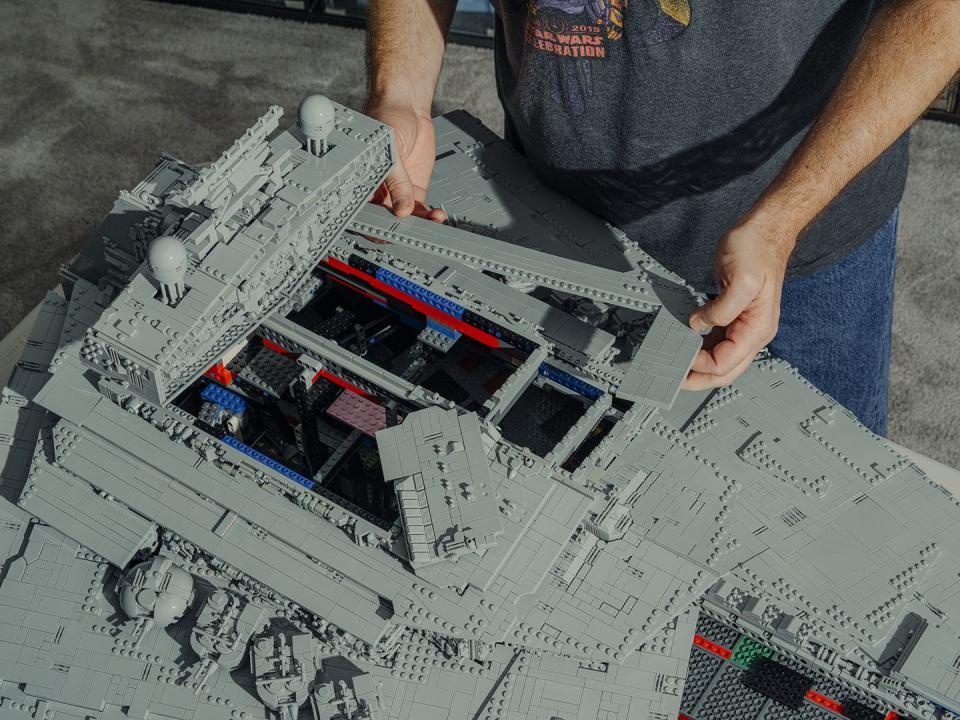
Trupia admits he walks a fine line between homage and bootleg. “We were really proactive when we started up, asking [the LEGO Group] what they wanted us to stay away from, especially franchise-wise.” The LEGO legal team provides Citizen Brick with disclaimers for their products, but Trupia still treads carefully. Citizen Brick won’t produce Star Wars toys, for example.
Still, Trupia doubts custom-printed LEGOs will take over the market. “It’s probably inevitable [people will use our custom pieces],” he says. “But 3D-printed pieces are not going to get anywhere close to the production quality of the real deal anytime soon.” Indeed, if you play around with 3D-printed pieces, you’ll find they’re often irregular, brittle, and hard to click together. From what Trupia’s seen, customers have no patience for that. “They’re incredibly loyal to LEGO,” he says. “Frankly, Citizen Brick wouldn’t exist if we didn’t pay the proper respects to the LEGO design aesthetic.”
So fan creators like Charles Anderson will stick with original and secondhand bricks rather than the remolded knockoffs. The classic LEGOs haven’t changed in 62 years, but modern builders are more ambitious, resourceful, and inventive than ever. Today, your first custom build can be a titanic, personal, one-of-a-kind masterpiece—and perhaps something as impressive as a 44-pound, 20,000-brick Imperial Star Destroyer.
You Might Also Like

